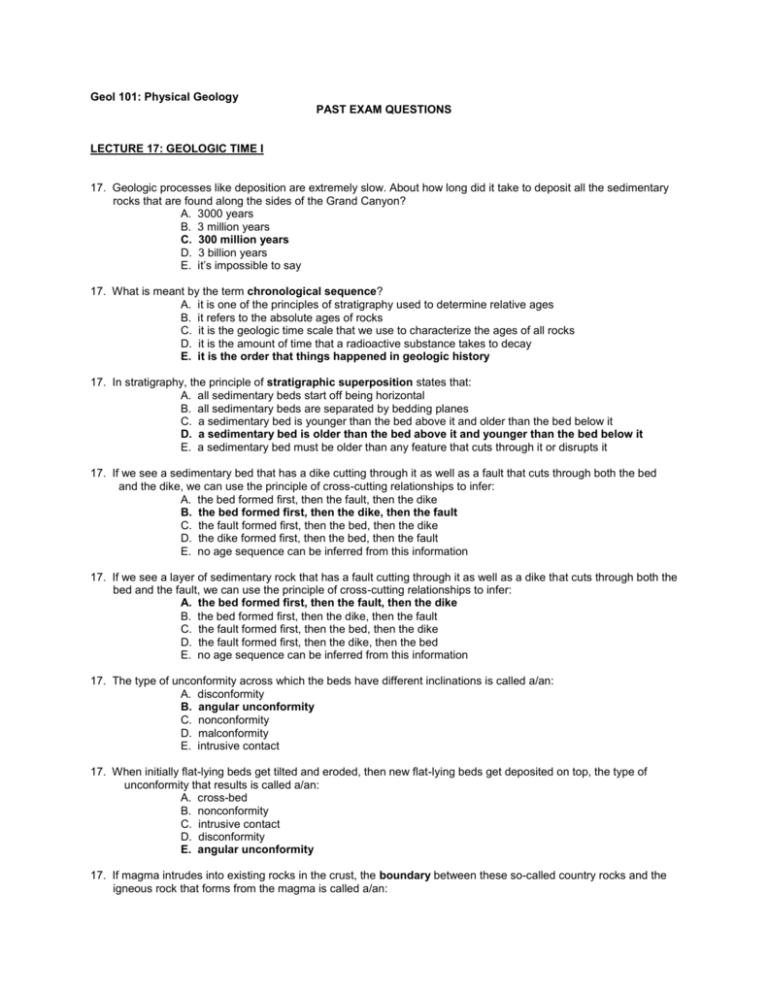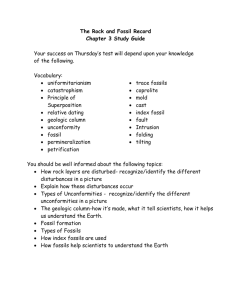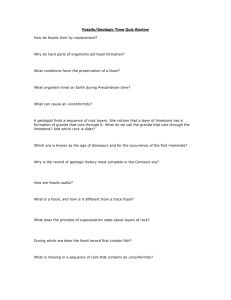Word
advertisement

Geol 101: Physical Geology PAST EXAM QUESTIONS LECTURE 17: GEOLOGIC TIME I 17. Geologic processes like deposition are extremely slow. About how long did it take to deposit all the sedimentary rocks that are found along the sides of the Grand Canyon? A. 3000 years B. 3 million years C. 300 million years D. 3 billion years E. it’s impossible to say 17. What is meant by the term chronological sequence? A. it is one of the principles of stratigraphy used to determine relative ages B. it refers to the absolute ages of rocks C. it is the geologic time scale that we use to characterize the ages of all rocks D. it is the amount of time that a radioactive substance takes to decay E. it is the order that things happened in geologic history 17. In stratigraphy, the principle of stratigraphic superposition states that: A. all sedimentary beds start off being horizontal B. all sedimentary beds are separated by bedding planes C. a sedimentary bed is younger than the bed above it and older than the bed below it D. a sedimentary bed is older than the bed above it and younger than the bed below it E. a sedimentary bed must be older than any feature that cuts through it or disrupts it 17. If we see a sedimentary bed that has a dike cutting through it as well as a fault that cuts through both the bed and the dike, we can use the principle of cross-cutting relationships to infer: A. the bed formed first, then the fault, then the dike B. the bed formed first, then the dike, then the fault C. the fault formed first, then the bed, then the dike D. the dike formed first, then the bed, then the fault E. no age sequence can be inferred from this information 17. If we see a layer of sedimentary rock that has a fault cutting through it as well as a dike that cuts through both the bed and the fault, we can use the principle of cross-cutting relationships to infer: A. the bed formed first, then the fault, then the dike B. the bed formed first, then the dike, then the fault C. the fault formed first, then the bed, then the dike D. the fault formed first, then the dike, then the bed E. no age sequence can be inferred from this information 17. The type of unconformity across which the beds have different inclinations is called a/an: A. disconformity B. angular unconformity C. nonconformity D. malconformity E. intrusive contact 17. When initially flat-lying beds get tilted and eroded, then new flat-lying beds get deposited on top, the type of unconformity that results is called a/an: A. cross-bed B. nonconformity C. intrusive contact D. disconformity E. angular unconformity 17. If magma intrudes into existing rocks in the crust, the boundary between these so-called country rocks and the igneous rock that forms from the magma is called a/an: A. B. C. D. E. disconformity angular unconformity nonconformity unconformity intrusive contact 17. The technique of using fossil assemblages to determine that two rock units in different locations formed during the same period of geologic time is called: A. evolution B. correlation C. bioanalysis D. paleontology E. stratigraphy 17. Fossils occur in a particular order through geologic time, producing a/an (1)______, so we can use fossils to (2)______ rocks having the same ages but occurring in different areas. This technique is a subdiscipline of geology called (3)_________. A. (1) faunal assemblage (2) compare (3) stratigraphy B. (1) faunal succession (2) correlate (3) biostratigraphy C. (1) fossil assemblage (2) date (3) paleontology D. (1) geologic column (2) date (3) sedimentology E. (1) absolute age indicator (2) correlate (3) stratigraphy 17. The presence of multiple species in the fossil assemblage of a sedimentary rock may help us narrow down the age of the rock because: A. we know the exact age of all types of fossils B. certain species only co-existed for limited periods of geologic time C. evolution prevents rocks with different ages from having the same types of fossils D. fossil assemblages can be used to correlate rock layers from place to place E. fossils contain radioactive elements that can be used to determine the age 17. Some rocks contain fossils of species that only lived for a relatively short time in Earth history. These are called: A. index fossils B. fossil assemblages C. fossil successions D. trace fossils E. Vanilla Ice fossils 17. A sedimentary bed contains three fossils: A, B, and C. Fossil A formed from an animal that only existed in the Cambrian and Ordovician Periods. Fossil B only existed in the Ordovician Period. Fossil C existed for a very long time on Earth- from the Cambrian to the Triassic Period. Based on this fossil assemblage, the age of the rock is: A. Cambrian B. Ordovician C. Silurian D. sometime between the Cambrian and the Triassic is all that we can tell E. impossible to determine 17. A sedimentary bed contains three fossils: A, B, and C. Fossil A formed from an animal that only existed in the Ordovician and Silurian Periods. Fossil B existed from the Silurian through to the Permian Period. Fossil C existed for a very long time on Earth- from the Cambrian to the Triassic Period. Based on this fossil assemblage, what must the age of the rock be? A. Cambrian B. Ordovician C. Silurian D. sometime between the Cambrian and the Triassic is all that we can tell E. it’s impossible to tell







